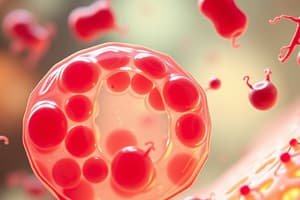Podcast
Questions and Answers
Which organelle actively transports H+ protons into the lysosome from the cytosol producing the acidic environment?
Which organelle actively transports H+ protons into the lysosome from the cytosol producing the acidic environment?
- H+ -ATPase (correct)
- Cytochrome c oxidase
- ATP synthase
- NADH dehydrogenase
Where are lysosomal enzymes synthesized before being transported to the Golgi apparatus for modification?
Where are lysosomal enzymes synthesized before being transported to the Golgi apparatus for modification?
- Rough endoplasmic reticulum (correct)
- Ribosomes
- Smooth endoplasmic reticulum
- Nucleus
What maintains the low pH within the lysosomes?
What maintains the low pH within the lysosomes?
- Proteases
- Phospholipases
- H+ -ATPase (correct)
- Nucleases
What is the main function of lysosomes in the cell?
What is the main function of lysosomes in the cell?
Which type of enzymes are lysosomal enzymes?
Which type of enzymes are lysosomal enzymes?
What is the shape of lysosomes?
What is the shape of lysosomes?
What are the lysosomal enzymes capable of breaking down?
What are the lysosomal enzymes capable of breaking down?
Where are lysosomal enzymes bud from to form primary lysosomes?
Where are lysosomal enzymes bud from to form primary lysosomes?
What is the diameter range of lysosomes?
What is the diameter range of lysosomes?
What do lysosomes contain to maintain the acidic environment?
What do lysosomes contain to maintain the acidic environment?
In which organelle does the synthesis of acetyl CoA take place?
In which organelle does the synthesis of acetyl CoA take place?
What is the waste product when acetyl CoA enters the citric acid cycle?
What is the waste product when acetyl CoA enters the citric acid cycle?
Where do the high-energy electrons enter in the electron-transport chain?
Where do the high-energy electrons enter in the electron-transport chain?
What is the enzyme responsible for the synthesis of ATP from ADP and inorganic phosphate?
What is the enzyme responsible for the synthesis of ATP from ADP and inorganic phosphate?
How many molecules of ATP are formed for each NADH in the electron-transport chain?
How many molecules of ATP are formed for each NADH in the electron-transport chain?
What is the function of mitochondria in the intrinsic pathway of apoptosis?
What is the function of mitochondria in the intrinsic pathway of apoptosis?
What are reactive oxygen species (ROS) produced as by-products of?
What are reactive oxygen species (ROS) produced as by-products of?
Which type of fat tissue is involved in the production of heat, and contains more vessels and mitochondria than white fat?
Which type of fat tissue is involved in the production of heat, and contains more vessels and mitochondria than white fat?
How is the human mitochondrial genome inherited?
How is the human mitochondrial genome inherited?
During zygote formation, which genome does a sperm cell contribute to the egg cell?
During zygote formation, which genome does a sperm cell contribute to the egg cell?
What is the function of lysosomes?
What is the function of lysosomes?
How are autophagosomes and multivesicular bodies (MVBs) related to lysosomes?
How are autophagosomes and multivesicular bodies (MVBs) related to lysosomes?
How do peroxisomes replicate?
How do peroxisomes replicate?
What is a key function of peroxisomes?
What is a key function of peroxisomes?
What is the main function of mitochondria?
What is the main function of mitochondria?
What are the four main compartments of mitochondria?
What are the four main compartments of mitochondria?
What is the function of the inner mitochondrial membrane?
What is the function of the inner mitochondrial membrane?
Where does anaerobic glycolysis take place?
Where does anaerobic glycolysis take place?
What is the function of the outer membrane of mitochondria?
What is the function of the outer membrane of mitochondria?
What is the composition of the intermembrane space of mitochondria?
What is the composition of the intermembrane space of mitochondria?
Flashcards are hidden until you start studying
Study Notes
Cellular Organelles: Lysosomes, Peroxisomes, and Mitochondria
- Lysosomes are organelles containing hydrolytic enzymes that digest cellular waste and extracellular components, formed from the fusion of primary and secondary lysosomes.
- Autophagosomes form to digest unnecessary or damaged cell organelles, and multivesicular bodies (MVBs) are developed for sorting ingested macromolecules before fusion with lysosomes.
- Peroxisomes are metabolic compartments surrounded by a single membrane, derived from the endoplasmic reticulum (ER), and contain over 60 different enzymes, including catalase and urate oxidase.
- Peroxisomes are involved in processes such as breakdown of fatty acids, detoxification, and lipid biosynthesis, including the synthesis of cholesterol, bile acids, and plasmalogens.
- Peroxisomes replicate by fission and contain integral membrane proteins synthesized in the ER, with a half-life of only 5 days.
- Mitochondria are energy organelles that use molecular oxygen to produce ATP, formed from pre-existing mitochondria by fission or budding.
- Mitochondria have four main compartments: outer membrane, intermembrane space, inner membrane, and inner space filled with matrix, containing specific enzyme complexes and mitochondrial DNA.
- The inner mitochondrial membrane is folded into cristae, contains phospholipid cardiolipin, and houses the enzymes of the respiratory chain and ATP synthase.
- Mitochondria serve as the energy center of the cell, converting energy from food into ATP through a process that includes anaerobic glycolysis, taking place in the cytoplasm.
- The outer membrane of mitochondria is smooth and contains porin molecules that form large aqueous channels for transport of pyruvate, fatty acids, and other molecules.
- The intermembrane space of mitochondria is chemically similar to the cytosol, while the inner membrane is highly specialized, containing specific transport proteins and being impermeable to ions.
- The inner mitochondrial space is filled with the matrix, where specific enzyme complexes metabolize pyruvate and fatty acids to acetyl CoA, and mitochondrial DNA and ribosomes are present.
Studying That Suits You
Use AI to generate personalized quizzes and flashcards to suit your learning preferences.




